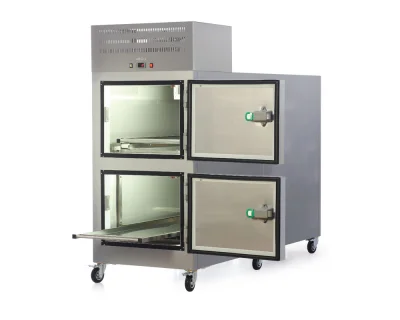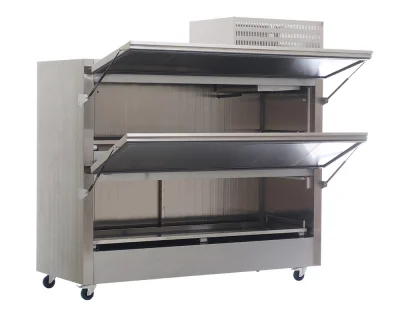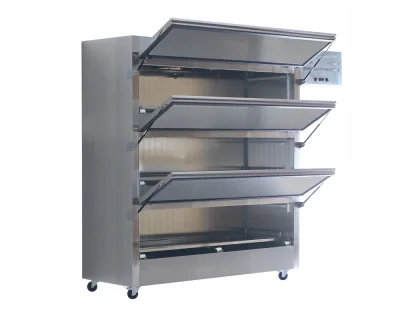Cadaver Storage Unit
- Designed for use in anatomy labs,
- Manufactured from 304 grade stainless steel,
- Odour system, roller system,
- Instrument shelf can rotate 360º, wetproof plug system,
- The cadaver storage pool consists of two parts, the first section The first section be formed with liquid pool and the second section be formed with covering,
- There is a 60 mm gap between two sections,
- Cadaver storage pools have 2-3-4 and 6 cadaver capacities,
- With cooling or without cooling system production is optional,
- The pool with cooling system has cadaver mousturising system,
- The unit works with hydraulic system. Cadaver can take off and put back by cadaver lift,
- Custom made production in different sizes and designs
| Code | Capacity | Type | Dimensions |
| MKSH 2502 | 2 Cadavers | Refrigerated | 100x250x105 cm |
| MKSH 2503 | 3 Cadavers | Refrigerated | 100x250x145 cm |
| MKSH 2504 | 4 Cadavers | Refrigerated | 160x250x105 cm |
| MKSH 2506 | 6 Cadavers | Refrigerated | 160x250x145 cm |
| MKSH 2512 | 2 Cadavers | Unrefrigerated | 86x240x105 cm |
| MKSH 2513 | 3 Cadavers | Unrefrigerated | 86x240x145 cm |
| MKSH 2514 | 4 Cadavers | Unrefrigerated | 145x240x105 cm |
| MKSH 2516 | 6 Cadavers | Unrefrigerated | 145x240x145 cm |
A Cadaver storage unit is a specialized refrigerated device that is used to store deceased human bodies, also known as cadavers. Body preservation chambers are designed to keep the bodies at low temperatures and slow the decomposition process.
Cadaver storage tanks are often utilized in medical schools, morgues, forensic labs, and research institutes. Anatomical storage cabinets create a controlled atmosphere in which the bodies are kept at temperatures lower than typical room temperature, which aids in the inhibition of bacterial development and decomposition.
The tanks are frequently outfitted with temperature controls and shelves or sections to accommodate many cadavers. Mortuary cold rooms may also include features such as humidity control and odor management systems to maintain the proper storage conditions.
For Corpse storage unit, formaldehyde is typically used in mortuaries or medical facilities for the preservation of deceased bodies. Formaldehyde is a commonly used chemical in embalming processes, as it helps to prevent decomposition and preserve the body for a longer period of time. Formaldehyde, a strong-smelling gas, is used as a preservative due to its ability to inhibit the growth of bacteria and other microorganisms that can accelerate decomposition. When bodies are placed in a cadaver storage tank, they are typically immersed in a solution of formaldehyde and water, known as formalin. This solution helps to preserve the body tissues and prevent decay.
As a Mixta, we are providing several options for Cadaver Storage Units; refrigerated, unrefrigerated.
A cadaver storage pool with refrigeration is identical to a regular cadaver storage tank, except it includes a refrigeration system. This refrigeration technology aids in maintaining even lower temperatures within the storage tank, slowing the decomposition process and improving cadaver preservation.
Refrigerated cadaver storage tanks are frequently used in environments that require long-term storage, such as medical research institutes, forensic laboratories, or anatomical donation centres. The refrigeration system contributes to the creation of a regulated environment that allows the bodies to be preserved for longer periods of time, allowing for anatomical investigations, research, and other objectives. These tanks are often built with adjustable temperature settings and may include features such as humidity control, odour management systems, and monitoring capabilities to guarantee optimum cadaver storage conditions.
There is a hydraulic lift system in the unit and it can move up and down with the help of a remote control.
The cadaver storage pool is produced with a capacity of 2-3-4-6 cadavers.
The MKSH 2502 code refers to our model that has a capacity for two cadavers and features a refrigerated design.











